Eagerly Awaiting the Results of Lot 21 Soil Samples
 Last Monday I noted that the Crown was now the new owner of Lot 21, c/o the surveyor of taxes. Lot 21, of course, is the property located immediately beside the site of the contaminated soil facility operating in the Shawnigan Lake watershed.
Last Monday I noted that the Crown was now the new owner of Lot 21, c/o the surveyor of taxes. Lot 21, of course, is the property located immediately beside the site of the contaminated soil facility operating in the Shawnigan Lake watershed.
In a media release that I issued on that day (February 15), I argued that the government no longer had any excuses to prevent it from thoroughly investigating the property. The government had previously told to me that drilling was not possible as the site was private property. But since Lot 21 returned to the Crown, I called upon government to undertake drilling to ensure residents, local and provincial governments and First Nations knew what, if anything, was buried on the site.
 Doing so would have put an end to speculation circulating in a prevalence of anecdotal stories. It would also have allowed the following question I had previously been left with to be answered directly:
Doing so would have put an end to speculation circulating in a prevalence of anecdotal stories. It would also have allowed the following question I had previously been left with to be answered directly:
What, if anything, has been buried on Lot 21 that could produce the Thorium, Lead and other heavy metal enrichment in the sediments?
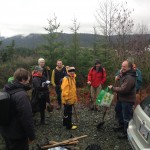 To my disappointment, the government failed to show the initiative to seek an answer to this question. As such, in order to address the concerns of my constituents who have property on Shawnigan Lake, I was forced to collect samples myself. And so, at 09:00 on February 19, my legislative assistant Aldous Sperl and I set off to the area to collect five soil samples.
To my disappointment, the government failed to show the initiative to seek an answer to this question. As such, in order to address the concerns of my constituents who have property on Shawnigan Lake, I was forced to collect samples myself. And so, at 09:00 on February 19, my legislative assistant Aldous Sperl and I set off to the area to collect five soil samples.
Upon our arrival at Stebbings Road we were greeted by a small group of local volunteers who were keen to help us out. Armed only with shovels, we set off on a several hundred metre hike to Lot 21.
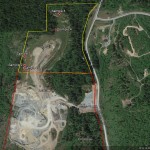 This must have been the fourth or fifth time that I have now hiked along the boundary of Lot 23 (containing the contaminated soil facility). On this particular journey, while fondly remembering my first and rather more difficult hike, I remarked how there was now a well worn path that had been created on the CVRD parkland. It seems that the route has now become oft travelled path.
This must have been the fourth or fifth time that I have now hiked along the boundary of Lot 23 (containing the contaminated soil facility). On this particular journey, while fondly remembering my first and rather more difficult hike, I remarked how there was now a well worn path that had been created on the CVRD parkland. It seems that the route has now become oft travelled path.
Prior to setting out on our journey my legislature office checked with the Ministry of Forests Lands and Natural Resource Operations (FLNRO) to ensure that there were no regulations prohibiting us from collecting soil samples. The Ministry directed us to FLNRO policy on Crown Land Use Policy that specifically stated, under section 6.2.3.3 Investigative Activities on Crown Land that:
Given the green light that we were given by FLNRO, Aldous, CVRD Director Sonia Furstenau and I set out to collect a total of fives samples from five separate locations on Lot 21 (see image above left for precise locations). Since automated drilling instruments were not allowed under FLNRO policy, we used shovels to dig the five samples at depths of 28″, 14″, 15″, 22″ and 0″, respectively,
Early on in our sampling we discovered a rather odd metallic cylinder with a plastic tube emerging from it (above left). As we felt that it was important to clean any debris off crown land, one of the local volunteers picked the cylinder up to examine and dispose of it at a later date. All holes that I dug were carefully refilled to ensure no disruption to “natural habitat” in the area.
Today I dropped off my soil samples at Maxxam Analytics for Volatile Organic, Total Hydrocarbon and Elemental Metal analyses. I expect results on Wednesday next week and I will report back immediately upon their receipt.

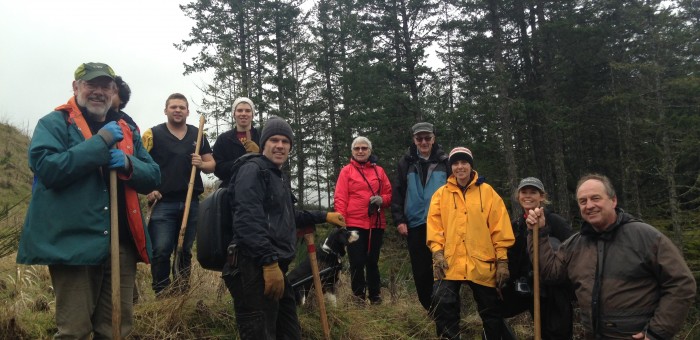
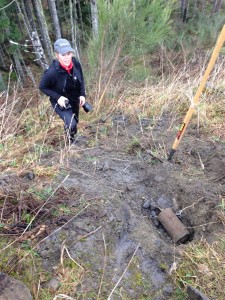
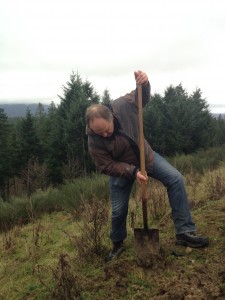
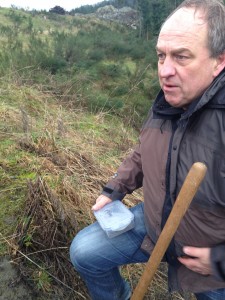
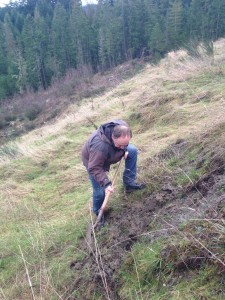
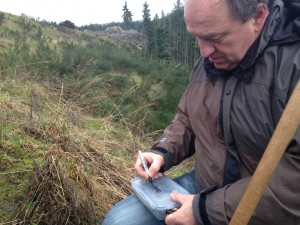
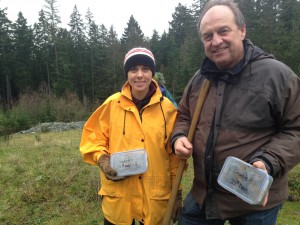


7 Comments
No need for the people to own this property anymore. The former owner paid his taxes. Let me ask, did you give this Maxxam any background on the sample? It is very easy to have a company have their reports bias in favour of the client. Samples should be taken properly by a qualified person, not some farmer and then sent to a lab across the country.
Perhaps you could pass along the information when title has reverted back to the owner. My understanding is that it may take some time for that to occur. Also, reputable companies do not bias their reports in favour of clients. I took samples to Maxxam (in Victoria not across the country) and asked them to do their standard tests. It’s a pretty straightforward procedure. And I’m not a farmer.
No, the samples should be sent across the country so there is no bias. Just like the court system not picking a jury from where a crime has taken place. And yes, labs can be bias, just like lawyers. You are paying them.
Sorry, I disagree. This would be incredibly unusual. The VOC, Hydrocarbon and Trace element analyses are standard. Nobody sends them across the country. That would be absurd.
Hi Andrew, I am not sure why you did not use industry standard soil sampling protocols. For example, the use of laboratory-supplied, analysis-specific sampling containers. You also should have used stainless steel shovels and cleaned the shovel between each of your sample locations. Your VOC results will not be valid as you did not appear to use the the required methanol-preservation method. I appreciate your efforts but your opponents (and the MoE) will be able to poke holes in your findings if you did not use the industry standard QA/QC sampling protocols.
I agree that the methods were not industry standard. The VOC measurements will be fine though. I recognize that there is concern for possible VOC leakage through plastic. But I have a ton of sample in there (they can select from the inner sample). The container was airtight. The numbers I get will be a lower bound of any VOC that the sample would contain. So if there are high VOCs in the sample, we know that it would only be higher on site. They can poke away all they want. I would encourage them to go back and do the same thing. Honestly, why should an MLA have to do this. It should be the province. Shovels were cleaned between digs.
Thanks for your response Andrew. I totally agree, it should not be up to an MLA to conduct the sampling. The government should retain a proper environmental consultant to conduct a complete environmental investigation to the full depth of the fill. Cheers.